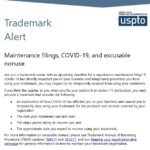USPTO Director Iancu releases his list of USPTO accomplishments 2018-2021. By James Michael Faier, M.P.P., M.B.A., J.D. (Registered Patent Attorney #56731)
The Director of the USPTO, Mr. Andrei Iancu, just released his list of accomplishments. I see no reference to the abandonment initiative that was discussed with INTA last year. I hear from contacts in the Examiner corps that the push goes on to adopt an expungement proceeding similar to the Canadian system. I do not see the point. The current cancellation system can be completed in about 80-days. With the cancellation system a litigant gets all the rights accorded by the Federal Rules of Civil Procedure. If the PTO proposes to cut time off the expungement proceeding then there has to be less time allocated to notice and the opportunity of a rights owner to move to avoid being washed out. I do not see the point of trying to replicate the Canadian system here. I advocated this position to the former Commissioner of Trademarks during her visit to INTA in 2019. But back to the list of accomplishments:
Highlights of USPTO Accomplishments (2018-2021)
1. Strengthened the USPTO’s Patent and Trademark Operations
- Reduced patent pendency to below 15 months for a first Office action and below 24 months for final disposition, the lowest patent pendency since 2001.
- Reduced ex parte appeal pendency to 13 months, down from 30 months in 2015.
- Accomplished mandatory electronic filing for all trademark filings.
- Developed artificial intelligence and machine learning tools for patent and trademark application processing and examination.
- Achieved permanent congressional authorization of the TEAPP telework program, which will ensure strong hiring, retention, and cost savings.
- Achieved enactment of legislation to allow the USPTO to limit response periods for trademark Office actions in order to further reduce pendency.
2. Increased the Certainty, Reliability, and Quality of IP Rights
- Issued Section 101 examiner guidance on patent eligibility, improving certainty of examination by 44%.
- Improved and added to patent examiners’ search tools, including launch of collaborative search pilot training and enhanced examiner search training.
- Established a new automated routing system for patent applications to help ensure incoming applications are best matched with examiners with relevant experience.
- Adjusted the performance appraisal plan for patent examiners to focus on improved search and examination quality.
- Reorganized senior patent management to broaden responsibility for operations and quality.
- Increased the rate of patent examiner interviews to an all-time high.
- Negotiated a revised policy with the U.S. Department of Justice and the National Institute of Standards and Technology on standard essential patents.
- Prepared and released multiple reports on public views on artificial intelligence and IP policy.
- Achieved the enactment of trademark legislation to strengthen trademark owners’ enforcement rights in court and to create additional tools for the USPTO to combat fraud on U.S. IP systems.
- Achieved the enactment of legislation to implement the Marrakesh Treaty, which enables greater access to copyrighted content by the blind, visually impaired, and otherwise print disabled.
- Multiple legislative achievements to balance and strengthen the copyright system.
3. Changed the Dialogue on IP
- Created a public relations and media campaign celebrating the patent system, including the signing of patent 10 million.
- Held Patents for Humanity awards ceremonies for inventors who create solutions to humanitarian crises.
- Achieved enactment of legislation to enhance the Patents for Humanity program by allowing the award benefits to be transferable.
- Conducted numerous briefings for Members of Congress and their staff on the importance of patents to producing lifesaving technologies.
- Promoted the induction of 56 inventors into the National Inventors Hall of Fame.
- Created the USPTO Speakers Series to allow leaders in the IP system to share innovation success stories with Office employees and the public.
- Created the Journeys of Innovation series on the USPTO’s home page to celebrate inventors and their personal stories.
4. Balanced AIA Review Proceedings at the Patent Trial and Appeal Board
- Promulgated rules to change claim construction standard to match district courts, to allocate burdens with respect to motions to amend, to respond to all claims and grounds in a petition, and to weigh all evidence at the institution stage equally for both patent owners and petitioners.
- Created a Precedential Opinion Panel to address important issues before PTAB.
- Designated numerous decisions as precedential and issued guidance memoranda to improve consistency of PTAB proceedings.
- Developed institution factors to reduce multiple patent challenges.
- Created a Motion to Amend Pilot Program to improve amendment process.
- Established standard operating procedures to improve transparency.
5. Bolstered the United States’ Leadership in IP
- Extended the U.S.’s lead as first in the U.S. Chamber of Commerce’s Global IP Index, and increased the U.S.’s rank in patents from twelfth (2018) to tied for second (2020) and in trademarks from fifth (2017) to tied for first (2020).
- Led effort to elect a WIPO Director General with strong support for intellectual property protection.
- Helped lead the Administration in adding new IP provisions as part of the USMCA.
- Achieved the first ever Parallel Patent Grant Agreement with Mexico and Patent Validation Agreement with Cambodia.
- Negotiated new work-sharing agreements with multiple foreign IP offices.
- Elevated the diplomatic rank of four USPTO IP Attachés.
- Worked with international IP forums to assist innovators and stakeholders to create
COVID-19 solutions.
6. Reduced Abuse of the IP System
- Established U.S. Counsel Rule to reduce fraudulent trademark filings.
- Worked with the National Crime Prevention Center to launch a nationwide public awareness campaign regarding the dangers of counterfeit products.
- Established a special task force to monitor and identify fraudulent trademark filing behaviors and to develop tools, including policies, to address them.
- Established a successful pilot program and then a permanent program to conduct random audits of post-registration maintenance and renewal documents to ensure the accuracy of the trademark register.
7. Strengthened the USPTO’s Fiscal Health
- Extended USPTO fee-setting authority for an additional eight years, through the end of 2026.
- Restructured patent and trademark fees to ensure better cost recovery.
- Increased the reserve fund to ensure stability and continuity of USPTO operations.
- Maintained USPTO operations during temporary suspension of funding.
- Identified $1B in diverted fees in the U.S. Treasury.
8. Expanded American Innovation
- Submitted the SUCCESS Act report to Congress, which studied participation rates among women, minorities, and military veterans in patenting.
- Prepared and released well-received Progress and Potential Report and update, which studied participation rates among women in patenting.
- Launched a National Council of private, academic, non-profit, and public sector executive-level leaders to expand American innovation.
- Created the LEAP program at PTAB for training and developing new patent attorneys, and established a PTAB law clerk program.
- Supported independent inventors, small business concerns, and nonprofit organizations in filing patent applications and encouraged collaboration with the federal Government by expanding the opportunities to qualify for the small entity discount for inventions made during the course of federally-funded or federally-supported research.
- Enhanced the USPTO’s home page to allow first-time inventors and small businesses to easily access a map of all the resources the USPTO offers in their local areas.
- Launched an online platform available on the USPTO website that provides resources for inventors and practitioners to encourage greater participation in the patent system.
- Renamed Alexandria headquarters’ auditorium after Clara Barton, the first public space at the USPTO ever named after a woman.
9. Ensured Continuous Operations During Pandemic
- Transitioned seamlessly to all telework presence for employees during pandemic.
- Transitioned to all-virtual board hearings.
- Successfully sought enactment of statutory authority to provide relief at the onset of the COVID-19 pandemic.
- Issued extensions of time for patent and trademark filing and fee deadlines, due to COVID-19 issues, within three days of enactment of statutory CARES Act authority.
- Established fast-track examination programs for COVID-19-related medical treatments and devices.
- Established the Patents 4 Partnership program to facilitate licensing of COVID-19 innovations.
- Launched the first all-virtual, entry-level training program to on-board over 400 new examiners.
10. Modernized the USPTO IT System
- Upgraded the USPTO IT system with new, faster, more efficient, and secure servers.
- Established redundant systems to ensure continuity of operations in case of certain IT failures.
- Initiated transition to the cloud for essential services.
- Rebuilt the USPTO website for a more modern look and a more interactive interface.













